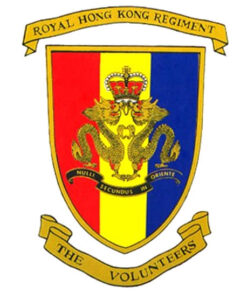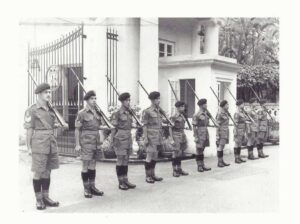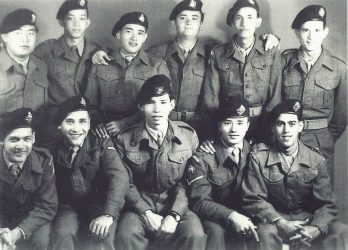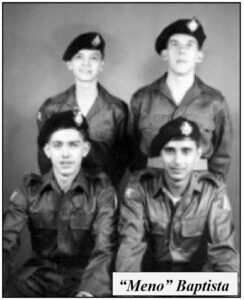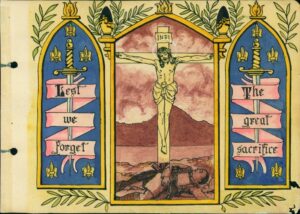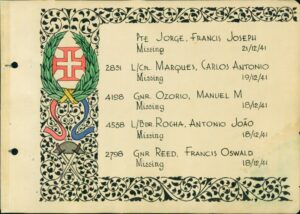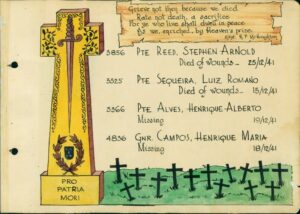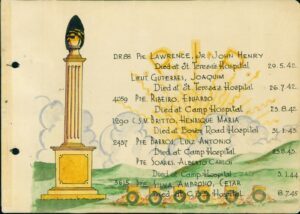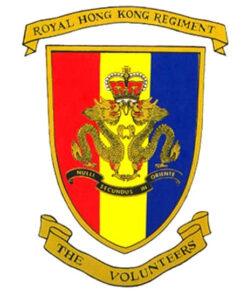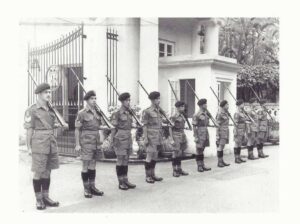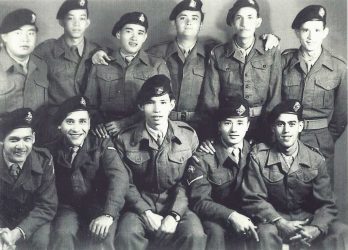The Royal Hong Kong Regiment (The Volunteers)
Originally published in the Bulletin of the Lusitano Club of California, Vol. 27 No. 1, Spring 2017
by Filomeno Baptista
The Regiment was formed in 1854 in response to an appeal by the Colonial Secretary. Ninety nine residents, mostly Portuguese, signed up becoming the first Volunteers. It was disbanded when threat to the Colony was over, reformed in 1862 disbanded and reformed again in 1866.
In 1917 owing to the recall of British forces from the Colony during World War I the Volunteers, being the only military unit, were engaged in guard and patrol duties but remained inactive during the 1920s until December 8th 1941.
The War
Throughout November 1941 Japanese forces were active across the border. The political situation was grave when in early December the garrison including the Volunteers, were mobilized and by the night of the 6th all troops were in their battle positions.
Against an enemy force of over 30,000 men, the defenders stationed a Brigade in the mainland comprised of the 2nd Battalion Royal Scots, the 2/14 Punjabis and 5/7 Rajputs. There were also the Field Company Engineers of the HKVDC, who were responsible for the demolitions of road and railway from Fanling to Shatin, and their 7 armored cars, responsible for patrolling the Castle Peak Road area.
The Island was defended by the Volunteers comprising: four artillery and one AA battery, three rifle companies (No 3 Company was to achieve immortal glory), three machine gun companies (Nos 5 and 6 were Portuguese Companies), one anti-aircraft company; the 1st Battalion Middlesex, the 1st Battalion Royal Rifles of Canada and the 1st Battalion Winnipeg Grenadiers.
Although vastly outnumbered and with no air cover, the defenders fought valiantly but by Christmas Eve it was apparent that further fighting would cause unnecessary death and suffering. On Christmas Day the defenders capitulated.
With the exception of the 2 Indian Regiments who were shipped back to India, the defenders were interned in Kowloon, officers in Argyle Street Camp and other ranks in Sham Shui Po.
Although conditions were harsh prisoners managed to maintain high morale by keeping active. A highlight were musical plays produced by a group of very talented men and in spite of their weakened state many participated in all forms of sports.
In 1943 large detachment of prisoners including many Portuguese were shipped to work the coal mines in Japan.
The life of prisoners was a mixture of sadness, fear, boredom and hunger. Although the Japanese guards were less brutal than in camps such as those in Burma never the less life was unpleasant in the extreme. This harsh situation lasted for 3 years and 8 months. In the morning of August 15th 1945 the prisoners woke to a strange silence. It took them some time to realize that, according to my Uncle Naneli,” there were no Japs in sight”. The camp guards had disappeared. Later they were informed by the camp commandant that the War was over. Until the arrival of the British Fleet on August 30th, the prisoners had to provide security of the Camp.
On September 16th to a 21 gun salute the Japanese signed the surrender paper at Governor House.
After the surrender, most of our boys travelled to Macau onboard a British warship to rejoin their loved ones, returning home after a few weeks to seek employment and places to stay. In May 1946 a Company of Volunteers were invited to participate in the Victory Parade in England.
Hong Kong Regiment “A” co. 3 Platoon c. 1955
Sai Kung Annual Camp Meeting
Collection Gerald McDougall
Top L-R: Bernardo Gomes, Carlos Noronha, Danny Osmund, Bobby Stewart, Bob Sequeira, Jojo Alonço
Bottom L-R: Dennis Nunes, “Lichi” Azevedo, Gerry McDougall, Boykee Mauricio, Eddie Remedios
Although the War was over many of our veterans chose to re-enlist. Their sons and brothers also joined in large numbers.
In 1949 the Regiment became part of the Hong Kong Defense Force. The combined force was granted the title “Royal” becoming The Royal Hong Kong Regiment and in 1957 was awarded the battle honor “Hong Kong”.
The Regiment continued to play an important role keeping order in the Colony, whether to guard against rioters or controlling illegal immigrants flooding into the safety of Hong Kong.
From its inception the Portuguese had supported the Regiment in large numbers, sons and grandsons of the original 99 signed up when they became eligible and continued to do so until the Regiment was disbanded in September 2nd 1995.
The Portuguese Volunteers who gave up their life in the battle of Hong Kong
They fought bravely and many gave their life defending Hong Kong.
Nulli Secundus in Oriente 1854-1995
(Second to None in the Orient, the motto of the Regiment).
O Regimento Real de Hong Kong (Os Voluntários)
Publicado originalmente no Boletim do Clube Lusitano da Califórnia, Vol. 27 N.º 1, Primavera de 2017
Filomeno Baptista
O Regimento foi formado em 1854 em resposta a um apelo do Secretário Colonial. Noventa e nove residentes, a maioria portugueses, alistaram-se, tornando-se os primeiros Voluntários. Foi dissolvido quando a ameaça à Colónia passou, sendo reorganizado em 1862 e novamente em 1866.
Em 1917, devido à retirada das forças britânicas da Colónia durante a Primeira Guerra Mundial, os Voluntários, sendo a única unidade militar, estiveram empenhados em tarefas de guarda e patrulha, mas permaneceram inativos durante a década de 1920, até 8 de dezembro de 1941.
A Guerra
Ao longo de novembro de 1941, as forças japonesas mantiveram-se ativas do outro lado da fronteira. A situação política era grave quando, no início de Dezembro, a guarnição, incluindo os Voluntários, foi mobilizada e, na noite do dia 6, todas as tropas se encontravam nas suas posições de batalha.
Contra uma força inimiga de mais de 30.000 homens, os defensores posicionaram uma Brigada no continente composta pelo 2º Batalhão de Escoceses Reais, o 2º/14º Batalhão de Punjabis e o 5º/7º Batalhão de Rajputs. Havia também os Engenheiros da Companhia de Campo do HKVDC, responsáveis pelas demolições da estrada e da ferrovia de Fanling a Shatin, e os seus 7 carros blindados, responsáveis pelo patrulhamento da área da Estrada do Pico do Castelo.
A ilha era defendida pelos Voluntários, compostos por: quatro artilharias e uma bateria antiaérea, três companhias de fuzileiros (a Companhia nº 3 alcançaria a glória imortal), três companhias de metralhadoras (as nºs 5 e 6 eram companhias portuguesas), uma companhia antiaérea; o 1º Batalhão de Middlesex, o 1º Batalhão de Fuzileiros Reais do Canadá e o 1º Batalhão de Granadeiros de Winnipeg.
Embora em grande desvantagem numérica e sem cobertura aérea, os defensores lutaram bravamente, mas na véspera de Natal era evidente que novos combates causariam mortes e sofrimento desnecessários. No dia de Natal, os defensores capitularam.
Com exceção dos dois regimentos indianos que foram enviados de volta para a Índia, os defensores foram internados em Kowloon, os oficiais no Campo da Rua Argyle e outras patentes em Sham Shui Po.
Embora as condições fossem severas, os prisioneiros conseguiram manter o moral elevado, mantendo-se ativos. Um ponto alto foram as peças musicais produzidas por um grupo de homens muito talentosos e, apesar do estado debilitado, muitos participaram em todas as modalidades desportivas.
Em 1943, um grande destacamento de prisioneiros, incluindo muitos portugueses, foi enviado para trabalhar nas minas de carvão no Japão.
A vida dos prisioneiros era um misto de tristeza, medo, tédio e fome. Embora os guardas japoneses fossem menos brutais do que em campos como os da Birmânia, a vida era extremamente desagradável. Esta situação dura durou 3 anos e 8 meses. Na manhã de 15 de agosto de 1945, os prisioneiros acordaram num estranho silêncio. Demorou algum tempo até perceberem que, segundo o meu tio Naneli, “não havia japoneses à vista”. Os guardas do campo tinham desaparecido. Mais tarde, foram informados pelo comandante do campo que a guerra tinha terminado. Até à chegada da frota britânica, a 30 de agosto, os prisioneiros tinham de garantir a segurança do campo.
A 16 de setembro, sob uma salva de 21 tiros, os japoneses assinaram o documento de rendição na Casa do Governador.
Após a rendição, a maioria dos nossos rapazes viajou para Macau a bordo de um navio de guerra britânico para se reunir com os seus entes queridos, regressando a casa após algumas semanas em busca de emprego e alojamento. Em maio de 1946, uma Companhia de Voluntários foi convidada a participar no Desfile da Vitória em Inglaterra.
Regimento “A” de Hong Kong, co. 3º Pelotão, c. 1955
Reunião Anual de Acampamento de Sai Kung
Coleção Gerald McDougall
Cima E-D: Bernardo Gomes, Carlos Noronha, Danny Osmund, Bobby Stewart, Bob Sequeira, Jojo Alonço
Baixo E-D: Dennis Nunes, “Lichi” Azevedo, Gerry McDougall, Boykee Mauricio, Eddie Remedios
Embora a guerra tivesse terminado, muitos dos nossos veteranos optaram por se realistar. Os seus filhos e irmãos também se juntaram em grande número.
Em 1949, o Regimento passou a fazer parte da Força de Defesa de Hong Kong. A força combinada recebeu o título de “Real”, tornando-se o Regimento Real de Hong Kong, e em 1957 foi condecorada com a honra de batalha “Hong Kong”.
O Regimento continuou a desempenhar um papel importante na manutenção da ordem na Colónia, quer para proteger contra os manifestantes, quer para controlar os imigrantes ilegais que invadiam Hong Kong em segurança.
Desde o seu início que os portugueses apoiaram o Regimento em grande número; filhos e netos dos 99 membros originais alistaram-se quando se tornaram elegíveis e continuaram a fazê-lo até à dissolução do Regimento em 2 de Setembro de 1995.
Os Voluntários Portugueses que deram a vida na batalha de Hong Kong
Lutaram bravamente e muitos deram a vida defendendo Hong Kong.
Nulli Secundus in Oriente 1854-1995
(Inigualável no Oriente, a divisa do Regimento).

